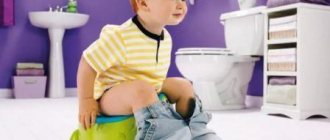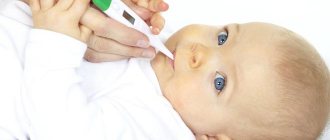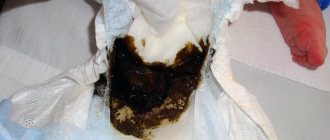Causes
Frequent bowel movements may be due to strong intestinal peristalsis, insufficient absorption of water by the walls of the large intestine, and the release of inflammatory exudate from the mucous membrane, which is provoked by infection. The cause of yellow diarrhea in a child can be:
- anatomical structure of the digestive tract;
- dysbacteriosis;
- intestinal infection;
- enzyme deficiency (enzymes that are necessary to break down nutrients are not synthesized or activated);
- inflammatory process in the intestines;
- binge eating;
- taking certain medications;
- poisoning with low-quality products or toxic substances;
- diseases of the cardiovascular system;
- introducing new products into the diet;
- stress and nervous exhaustion.
If the diet is monotonous, then nutritional diarrhea may develop. The normal color of stool in a child over one year old with a rational mixed diet is dark brown, which is due to bilirubin derivatives. If the diet is dominated by meat products, then the stool takes on a black-brown tint, and if it is plant-based, it will be light brown. If your baby eats only dairy products, the stool will be light yellow.
Black stools can be due to bleeding from the stomach, esophagus or duodenum, or due to the consumption of blueberries, black currants, coffee, medications containing bismuth, carbolene. Stool will appear greenish-black after taking iron supplements. Eating only vegetables stimulates increased peristalsis, and bilirubin and biliverdin make the stool green.
If yellow diarrhea in a child occurs due to eating disorders (overeating, a monotonous diet, eating a new product in large quantities or difficult-to-digest food) or during teething, and the child’s health is satisfactory, then taking medications is not required, and the symptom is eliminated by diet therapy.
Why does children have white diarrhea?
Physiological (non-hazardous) probable causes
White diarrhea in a child is not a natural phenomenon, but parents should not immediately get scared and assume that their baby has some serious illness. Usually the first thing that inexperienced parents think about is liver pathology. And, despite the fact that a light shade of feces does signal hepatitis, this disease also has other characteristic signs. For example, dark, thick urine. Therefore, if your baby’s urine still remains light, liquid and transparent, the white color of the stool has a different reason.
In most cases, white diarrhea with flakes and lumps that has recently appeared in a baby is not a sign of a serious illness, but only indicates poor nutrition. Such diarrhea may appear in response to excessive consumption of fatty or sweet foods.
White color of stool can sometimes appear with the introduction of the first complementary foods to a child who was previously breastfed. Or when adding new foods to the children's diet that the baby has not yet tried. It happens that a child defecates with colorless diarrhea during teething. If a baby is bottle-fed, some formulas may turn his stool white.
In the second or third year of life, white, loose stools may be due to a large amount of carbohydrates or dairy products in the child’s diet. At this age, the immature digestive system is not yet able to completely break down and absorb them.
Liquid, whitish stools may appear under the following circumstances:
- consumption of poor quality drinking water;
- failure by parents to comply with basic hygiene rules when caring for a baby;
- family moving to another climate zone;
- errors in daily routine and diet.
It also matters how often white diarrhea occurs, whether this disorder of intestinal function is random or systematic. If you had a problem with stool once or twice, then don’t worry, there’s nothing to worry about.
In all of the above cases, parents should not be frightened by the white color of children's diarrhea. You just need to review the child’s menu, adjust the daily routine and nutrition, and the stool will return to normal.
When to rush to the doctor
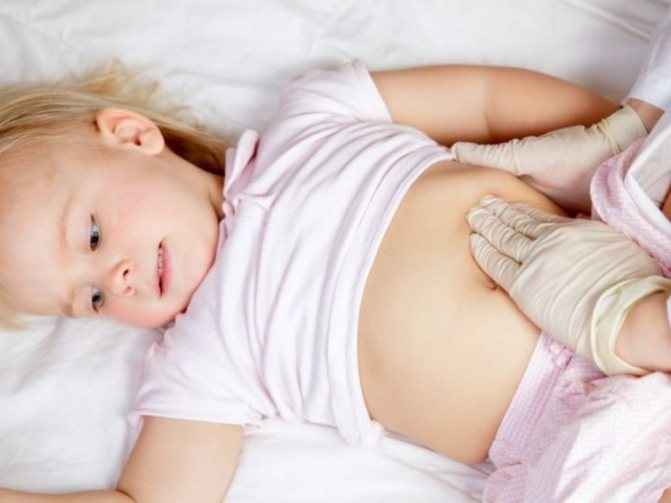
If this disorder has a persistent, protracted course and is accompanied by the child’s general poor health and other formidable symptoms, then this is a reason to contact a pediatric gastroenterologist and pediatrician for a thorough examination, diagnosis and treatment.
So, serious causes of white diarrhea in a baby:
- Partial or complete blockage of the bile ducts, interfering with the functioning of the gallbladder. The yellowish color of stool is due to the admixture of bile, and if its outflow is impossible or difficult, the stool remains white. There may be a delay in the free release of bile due to bending or twisting of the gallbladder.
- Impaired liver function due to improper use of any medications (antibiotics, paracetamol, ibuprofen).
- Inflammation of the pancreas (pancreatitis), which makes itself felt by acute pain in the child’s upper abdomen, nausea, vomiting, belching, high fever, profuse sweating, tachycardia (rapid heartbeat), yellowness of the skin and dark urine.
- Disturbance of the intestinal microflora caused by fungal diseases, taking antibiotics or a sudden change in diet.
- Inflammation of the intestines (enteritis or enterocolitis), other than white mucous diarrhea, accompanied by severe thirst, vomiting and high fever. Sick children complain of abdominal pain, cry, are capricious, and have difficulty sleeping.
- Insufficient intestinal absorption.
- Infection with helminths.
- Inflammation of the liver (hepatitis). With this disease, the color of stool gradually lightens, changing from light yellow to completely colorless. However, with hepatitis there are a number of characteristic signs, for example, darkening of urine and yellowness of the whites of the eyes and skin.
In any case, if white diarrhea is repeated many times, it should not be left without close attention. It is necessary to tell your doctor about all symptoms. The specialist will find out the cause of problems with bowel movements and prescribe treatment.
Stool color as a symptom
If the color of stool cannot be explained by a monotonous diet or use of medications, then it can be considered as a diagnostic criterion:
- Green diarrhea occurs if there is an infection of viral or bacterial origin in the digestive tract. Staphylococcal bacteria are found in stool, which gives it a greenish tint. In addition to diarrhea, the child is worried about abdominal pain, nausea, vomiting, weakness, and increased body temperature;
- The black color of stool is due to the presence of oxidized hemoglobin, which can enter the stool from stomach or duodenal ulcers. If Helicobacter multiplies in the stomach, the diet is not followed, the diet contains a lot of spicy, heavy or fatty foods, or there is a chronic gastrointestinal disease, then a peptic ulcer can develop in a 5-year-old child. This disease requires urgent treatment;
- if biliary excretion is impaired, the stool becomes grayish-white in color (acholic stool) as a result of the absence of decomposed bilirubin in it. White stool and dark urine indicate liver dysfunction;
- Yellow stool occurs if the contents of the intestine do not have time to mix with bile, since intestinal motility is increased and the passage of feces is accelerated. Infections, medications, toxic substances, and stressful conditions can lead to increased physical activity.
Based on only one symptom, it is impossible to determine the cause of the pathology; it is necessary to consider the clinic as a whole.
Intestinal infection
If, in addition to yellow diarrhea, the child experiences fever, vomiting, nausea, and weakness, then there is a high probability of developing an infection in the digestive tract. Intestinal infections most often develop in young children due to lack of hygiene skills. In children under three years of age, the disease is more severe and can cause dysbiosis, enzyme deficiency, and a decreased immune response.
Intestinal infection is caused by gram-negative enterobacteria (Shegella, Salmonella, Eschirichia, Yersinia, Campylobacter), opportunistic bacteria (Staphylococcus, Proteus, Clostridia, Klebsiella), viral agents (rotaviruses, adenoviruses, enteroviruses), protozoa (Giardia, amoeba, coccidia), mushrooms.
With dysentery and salmonellosis, the stool is profuse, containing mucus and blood. With escherichiosis in children, watery diarrhea occurs (defecation is yellow water mixed with mucus), and blood may be present in the stool. Rotavirus infection causes watery, foamy stools up to 15 times a day.
The causative agent of the disease can only be identified through laboratory testing. Etiotropic therapy is carried out with antibiotics, intestinal antiseptics, and enterosorbents. It may be necessary to take specific bacteriophages, immunoglobulins or lactoglobulins, so treating an intestinal infection on your own is not recommended.
Poisoning
The occurrence of vomiting, nausea and diarrhea may indicate poisoning with low-quality products or toxic substances (plant or chemical origin). In this case, abdominal pain is most often cramping in nature and intensifies during bowel movements. The stool is watery with mucus and streaks of blood, its frequency can reach 10 times a day.
In severe cases, body temperature rises, intoxication syndrome increases, and dehydration begins. In a newborn, diarrhea most often occurs due to the consumption of poor-quality food. If the poisoning is severe, the stool becomes foamy (white foam).
For children under one year of age, diarrhea is a serious symptom because it can quickly lead to dehydration, which can be fatal, so seek medical attention as soon as possible. It is possible to identify the causative agent of foodborne toxic infection using bacteriological culture of feces, vomit, and gastric lavage.
Enzyme deficiency
If there is no enzyme that breaks down the substance, or if it cannot be activated in the small intestine, they speak of enzyme deficiency. In children, the disease is most often congenital. Undigested fats enter the lumen of the large intestine, stimulate cell secretion, which is why diarrhea occurs. The stool has a fetid odor, its surface is oily, shiny, the color can range from dull yellow to gray, and undigested food is noticeable in the stool. Children eat poorly and do not gain weight.
The main symptom of lactase deficiency is fermentative diarrhea, which is manifested by frequent, loose, foamy stools with a sour odor. A child can defecate 10–12 times a day. When dairy products are excluded from the diet, the baby’s condition improves and he begins to gain weight. Lactase is synthesized in smaller quantities with age, so the disease can develop even by 4 years, despite the fact that milk was well absorbed in infancy or early age.
Diarrhea color
This or that disease may depend on the color of the stool; if diarrhea and accompanying symptoms occur, you should consult a doctor for appropriate treatment. If the diarrhea is green or light green in color, then this indicates a bacterial or viral infection; the color of the stool becomes this way because leukocytes accumulate in them and staphylococci multiply. Loose stools have a patchy consistency, may contain a large amount of mucus and be green or light green in color. The child also develops abdominal pain, nausea, vomiting, high body temperature, lethargy, general intoxication of the body, and changes in blood counts.
- Diarrhea that is yellow or light yellow in color is considered most favorable. Most often, it occurs due to increased intestinal peristalsis, when feces move quickly, they do not have time to form into the required form, but undergo complete enzymatic processing, so the stool is yellow. There are no special clinical manifestations; sometimes cramps and heaviness in the abdomen occur.
- Loose stools that are black or dark in color should alert parents. But you don’t need to immediately think about the presence of internal bleeding, since the coloring of stool can also be caused by foods eaten or medications. It is necessary to monitor clinical manifestations and if the color does not normalize, consult a doctor immediately.
- White or light-colored diarrhea indicates a dysfunction of the bile ducts, bile does not process food sufficiently and the stool becomes light in color.
What causes diarrhea?
Based on the accompanying signs, a preliminary diagnosis can be made, but for a final conclusion it is necessary to undergo laboratory and instrumental examinations. One of the most common symptoms that accompanies loose stools is high body temperature, which especially increases with microbial, viral and bacterial infections. Foreign protein structures are introduced into immune cells, all this leads to the appearance of antibodies and the release of inflammatory mediators, which in turn leads to an increase in temperature, it ranges from 37.1 to 39 degrees, thus the body fights the disease.
Nausea and vomiting also often occur along with frequent stools, because the movement of food masses through the intestines is incorrect and they change the direction of reflux. Toxins also enter the bloodstream and are distributed to all organs and tissues, the vomiting center of the brain reacts to them and a gag reflex appears, thus the body is partially cleansed of toxic products. Due to increased intestinal motility, painful sensations appear in the abdomen, they are usually cramping and intense in nature, the pain intensifies before or during the urge to defecate.
Eliminating diarrhea in a child
If a child has loose stools once, then there is no need to start drug therapy. It is necessary to remember what foods were in the baby’s diet over the last 24 hours and, if the symptom repeats, analyze whether there is a pattern. Thus, it will be possible to identify foods to which the child has an individual intolerance, and in order to reduce the load on the digestive system, they simply need to be excluded from the diet.
If pathological inclusions are visible in the stool, such as fat, food particles, a large amount of mucus, or blood, then you need to take blood and stool tests, and undergo an ultrasound examination of the abdominal organs. Only after an examination will it be possible to make a diagnosis and prescribe adequate therapy that eliminates not the symptom, but the cause of the disease.
If diarrhea is frequent and profuse (regardless of the color of the stool), then you should seek medical help. To prevent the development of dehydration, children under one year of age are recommended to be hospitalized for infusion therapy.
Diet therapy
If yellowish diarrhea occurs, regardless of the cause of the symptom, a therapeutic diet No. 4 is prescribed, which helps reduce the load on the digestive tract and reduces the severity of putrefaction and fermentation processes in the intestines. It is recommended to feed the child in reduced portions, but more often, so that food is absorbed in the intestines and does not pass through in transit.
Any foods that stimulate the secretion of gastric juice and intestinal motility should be removed from the menu. Cold drinks and dishes have a laxative effect, so they should not be given during diarrhea. To reduce the severity of the fermentation and putrefactive process, you need to remove legumes, cabbage, fatty meat, milk, fresh vegetables and fruits from the diet.
When yellow diarrhea appears, a child's menu may include mucous soups, cereals, dietary meat and fish, crackers, fermented milk products, jelly, and jelly. All dishes must be steamed or boiled. Diet is an important component of therapy, so compliance with it is mandatory for several more days after the yellow diarrhea disappears.
Drug treatment
Enterosorbents are used to eliminate diarrhea. These drugs are not absorbed in the digestive tract, but pass through it, absorbing toxic substances. The product helps compact stool and slow down its passage. Enterosorbents are divided into absorbents (convert liquid toxins into a solid substance, so that they are not absorbed into the bloodstream), adsorbents (absorb poisons like a sponge) and chemical absorbers (react with poison).
Taking sorbents is contraindicated for chronic inflammatory diseases of the gastrointestinal tract, intestinal atony, bleeding from the digestive tract. Taking this product accelerates the elimination of toxic compounds, but it has no effect on bacteria and viruses that secrete these substances, therefore, for intestinal infections, the sorbent only reduces the severity of the symptom.
Sorbents are prescribed for children in case of poisoning, an allergic reaction, or indigestion. Most often, young patients are recommended:
- Smecta. The drug additionally coats the intestinal walls, protecting them from irritation. Children under one year of age are given two sachets of the product per day for three days. For older children, first give a dose of 4 sachets, and then reduce it by half. The drug has almost no side effects (constipation or dermatological reactions may occur).
- Polysorb. Has a high degree of adsorption. The dosage of the medicine is calculated based on the child’s weight (per 10 kg daily dose 2 grams).
- Enterosgel. Available in the form of a sweet paste. Children from one to 5 years old are given a teaspoon three times a day. In case of acute poisoning, the first dose is doubled. Children under 14 years of age are given medication by dessert spoon, also three times a day.
- Polyphepan. Available in powder, which must be diluted with water. Children under one year old are given a teaspoon of the product, children under seven years old the dose is increased to a dessert spoon.
- Activated carbon is given to children over seven years of age.
Intestinal antiseptics can also be used to treat diarrhea, for example:
- Enterofuril. Available in the form of yellow capsules or suspensions. Refers to broad-spectrum antimicrobial agents. In case of acute bacterial diarrhea, it restores the intestinal microflora; in case of infection with enterotropic viruses, it does not allow the development of superinfection. Indications for use are bacterial diarrhea without fever, intoxication or deterioration of general condition. Capsules are given to children over three years of age; the yellow suspension is suitable for treating children from one month of age.
- Baktisubtil. Refers to eubiotics. Contains bacteria that produce broad-spectrum antibiotics that inhibit the growth of pathogenic and opportunistic bacteria. The product has an antidiarrheal effect and restores intestinal microflora. Prescribed for children over 7 years of age.
- Nifuroxazide. An antimicrobial agent that reduces the production of toxic substances by bacteria. Does not cause dysbacteriosis. Prescribed for children over 6 years of age.
If yellow diarrhea in a child occurs as a result of long-term antibacterial therapy, then drugs are prescribed that normalize the microflora of the large intestine. These can be probiotics or prebiotics containing the necessary lacto- and bifidobacteria or a substrate for their accelerated development. They may prescribe Bifidumbacterin, Lactiale, Lacidofil.
If yellow diarrhea is caused by a disease of the digestive system (liver, pancreas, stomach, intestines), then several groups of medications are required. For example, to restore liver function, vitamins, hepatoprotectors, and choleretic drugs can be prescribed, and to reduce the inflammatory process in the stomach, antacids and antihistamine receptor blockers cannot be used.
With increased intestinal motility, antidiarrheal drugs, for example, Imodium, are prescribed. To combat intestinal infections, antibacterial or antiviral drugs are prescribed that destroy the pathogen. If no specific treatment has been developed, then symptomatic therapy is carried out (droppers are placed to normalize the water-salt balance, antipyretics and enterosorbents are given).
For food allergies, medications that reduce the effect of histamine are prescribed. This could be Alerzin, Zodak, Tsetrin. Diarrhea and vomiting are the body’s protective reaction to the presence of pathogenic bacteria and viruses in the digestive tract, as well as toxins that affect the mucous membrane. It is not advisable to relieve these symptoms; it is necessary to treat the disease that caused the symptoms, so medication should be prescribed by the attending physician.
If a child has diarrhea, then it is necessary to adjust his diet and increase the amount of fluid consumed in order to normalize the water-salt balance. If additional symptoms appear (nausea, fever, flatulence, headache and abdominal pain, foreign impurities in the stool), you should call a doctor. The doctor will tell you what to do if bright yellow or yellow-green diarrhea occurs after a physical examination of the child and assessment of his condition.
The child's body has its own characteristics of functioning. The gastrointestinal tract is no exception. In children, it is still immature, and the secretory function of the digestive glands is low. The color of stool depends on many factors, including the food you eat. Since the main food of infants is milk, it is not surprising that the color of stool and the frequency of bowel movements differs from adults. What to do if a child has yellow diarrhea? What kind of feces is normal for infants?
Yellow diarrhea in a child - features and treatment
For children under one year old, loose stools are a common and fairly common occurrence. The yellow color of stool is perceived normally by both parents and doctors. Therefore, there is no need to worry about this. If diarrhea appears suddenly or continues for a long time, you should consult a pediatrician to prevent more serious illnesses.
Yellow diarrhea in children must be treated with great care, as it is accompanied by dehydration, which is extremely dangerous for the child. Treatment begins as early as possible, with plenty of fluids and probiotics.
When yellow diarrhea in children indicates a serious illness:
- if a child has yellow diarrhea and the cause is the consumption of stale, low-quality, unwashed foods;
- when diarrhea is accompanied by a temperature rise above 38°C;
- prolonged diarrhea, especially if bloody or mucous discharge is present;
- sudden diarrhea for no apparent reason;
- if yellow, loose stools are accompanied by sharp, cramping pain in the abdomen;
- when the color of urine changed, it became darker;
- if diarrhea provokes weight loss, the child loses weight before our eyes;
- the appearance of signs of dehydration - lips crack due to dryness, no urine, no tears;
- yellowed eyes and skin with diarrhea;
- simultaneous occurrence of diarrhea in several people (in a family, kindergarten, summer camp);
- loose stools appeared after a trip to another country.
The sudden onset of diarrhea, accompanied by vomiting and fever, is especially dangerous for children under one year of age. Therefore, you need to see a doctor as soon as possible and start treatment.
In case of yellow diarrhea in children, monitor changes in the skin - if the skin is dry or yellowing, as well as crying without tears or sunken eyes, you should immediately call an ambulance to prevent dehydration of the child’s body.
Diarrhea caused by taking antibiotics is also dangerous. In this case, the doctor should reconsider the treatment and prescribe other drugs. Do not risk your health and the health of your loved ones - yellow diarrhea can be as dangerous as other diseases. Contact your doctor promptly and begin treatment immediately.
Healthy adult stool is shaped and brown in color. Feces are eliminated from the body naturally once or twice a day. If intestinal functions are impaired, stool changes consistency and takes on a different color. Yellow diarrhea is a sign of a disorder in the body that requires diagnosis and treatment.
Deviations in the act of defecation require close attention and sometimes treatment. Bile takes part in the formation of feces, coloring them brown. Lack of liver product results in yellow stools. Another reason for yellow stool may be the rapid removal of feces from the intestines, which have not had time to form and acquire a natural color. The most common causes of loose stools:
- Viral and bacterial infections.
- Infection with staphylococci.
- Side effects of medications.
- Inflammation of the pancreas.
- Liver dysfunction. A lack of bile salt, which is responsible for the proper functioning of the digestive tract, contributes to the appearance of yellow liquid stool.
- Inflammation of the colon mucosa.
- Food intolerance.
- Hormonal disbalance. Yellow diarrhea in women can occur during menopause or pregnancy.
- Inflammatory changes in the gastric mucosa.
With salmonellosis, the stool has a dark yellow or green tint and mucus is present.
With dysentery, the stool is green and watery. Yellowish, loose stools that turn gray indicate rotavirus infection. Ulcerative colitis causes light yellow stools containing blood and pus. Bright yellow, foamy diarrhea can be caused by staph. Mustard-colored stool is caused by bacteria. With intestinal candidiasis, the stool is liquid with white flakes. A beige color indicates liver damage.
Orange, red stools are caused by eating foods containing large amounts of carotene. If such products are not consumed, the cause may be hepatitis, stomach ulcers, or cystitis.
Diarrhea may occur when changing water and food in travelers.
Yellow diarrhea due to poisoning
When the body is intoxicated, inflammation of the gastrointestinal tract occurs due to the entry, reproduction, death and decomposition of microbes. Such processes irritate the mucous membrane and promote inflammation. Inflamed mucous membrane provokes the production of serous fluid. The intestinal walls lose their ability to function properly and do not absorb moisture that enters it. Excess moisture provokes light-colored diarrhea.
Poisoning is characterized by cramps, high fever, a feeling of nausea, and incessant vomiting. Intoxication is accompanied by weakness and dizziness.
The disease that causes loose stools of an unnatural color cannot be determined without a thorough examination.
Normal stool in a baby
Diarrhea is an increase in the frequency of bowel movements. The intestinal motor function of a one-month-old baby is quite energetic, which is manifested by frequent bowel movements: in the first two weeks in a newborn - 3-5 times, during the first year of life - 1-3 times a day, in a one-year-old child - 1-2 times a day. In infants, the process of defecation is a spontaneous (reflex) act, and starting from two years of age, bowel movements are a voluntary (conscious) process.
Causes of diarrhea
Why does a child have yellow diarrhea? In a young child, loose yellow stools can occur for a number of reasons:
- violation of feeding regime;
- improper introduction of complementary foods;
- changing the diet of a nursing mother;
- intestinal infections;
- diseases of the stomach, pancreas, liver;
- overfeeding the baby;
- intestinal dysbiosis;
- lactase deficiency;
- teething.
In an infant, diarrhea after antibiotics may occur due to the suppression of normal intestinal microflora by antibacterial drugs. In this case, it is necessary to undergo a stool culture for dysbacteriosis, a stool analysis for opportunistic microflora and coprogram. Based on the test results, the doctor will be able to prescribe adequate treatment.
Loose stools in infants often occur during teething. At the same time, the baby begins to salivate profusely and the temperature may even rise slightly.
Frequent, liquid, yellow, foamy stools in a newborn may be a sign of physiological dysbiosis. It occurs during the first two weeks of a child’s life, as the intestines are actively populated by new microflora. At the beginning of the 3rd week in healthy full-term infants after feeding with mother's milk, this condition self-liquidates. Frequent loose stools with white lumps can also be a sign of dysbiosis.
Foamy diarrhea in a child without fever occurs with lactase deficiency, increased gas formation and allergies to foods that the nursing mother eats.
Water diarrhea in a child: treatment
Treatment of diarrhea with water in a child must be previously agreed with a doctor. Without his consultation, you can give your child only sorbents, drugs that slow down motor skills, and agents that restore water-salt balance. During treatment, children are usually also prescribed drugs that restore intestinal microflora. A big role is also given to nutrition and drinking plenty of fluids.
Among the folk remedies for treating diarrhea with water in children are herbal teas with mint and chamomile. Also in such cases, rice water helps a lot, drinking a third of a glass every 2-3 hours. Among other remedies for watery diarrhea, the most popular are: starch solution (a teaspoon per 100 ml of cold water), pear decoction, powder from dried films of chicken stomachs, tincture of walnut partitions, rice porridge in water without salt, and others.
When to see a doctor?
In the first months of life, it is quite difficult for parents to determine whether a child has diarrhea, since bowel movements occur much more often than in adults.
Signs of "danger":
- the number of daily bowel movements exceeds the norm;
- accompanied by an increase in temperature;
- the child refuses to eat;
- diarrhea with foam in a child;
- yellow diarrhea with mucus;
- watery stools;
- vomiting, nausea;
- the baby is constantly restless, cries, knocks his legs or is lethargic;
- signs of dehydration: the newborn’s fontanel is sunken, the mucous membranes are dry;
- there is mucus in the stool; after the introduction of complementary foods, there may be pieces of undigested food.
If at least one of the above symptoms appears, you should immediately consult a pediatrician to determine the causes of diarrhea in children.
In a newborn, loose stool “water” always leads to dehydration and is a very dangerous condition. What to do in this case? Treatment involves adequate replenishment of the body's water balance. Rehydration agents are administered intravenously or orally, depending on the degree of fluid loss.
Frequent loose stools with white lumps may indicate severe intestinal dysbiosis. This condition can also occur in children who are bottle-fed, since not all formulas are equally well digested in the child’s gastrointestinal tract.
Yellow diarrhea with foam
The presence of foamy diarrhea in a child may indicate lactose intolerance. Since milk predominates in the baby’s diet, it is quite simple to identify this pattern, since dairy products cause fermentation in the abdominal cavity, which leads to foamy discharge. In this case, doctors prescribe drugs that contain enzymes to break down lactose.
If diarrhea with foam is accompanied by bloody discharge, this may be the cause of a disease such as ulcerative colitis, or the presence of an anal fissure. This is a serious reason to contact your pediatrician!
Types of diarrhea
Foamy diarrhea in an infant, which has a strong odor and is accompanied by an increase in temperature, as well as symptoms of intoxication, indicates the presence of an intestinal infection. Classification of acute intestinal infections by type of diarrhea:
- Invasive type. Acute intestinal infections of bacterial etiology. They are caused by Salmonella, Shigella, some types of Escherichia, Yersinia and other pathogens. Pathogens can invade the epithelium of the gastrointestinal tract and cause foamy stool. Watery diarrhea with yellow-green mucus mixed with blood in a child often indicates salmonellosis. Green stool and small amounts (“rectal spitting”) indicate the occurrence of shigellosis.
- Secretory type. Such diarrhea in an infant can be of bacterial etiology (Vibrio cholerae, enterotoxigenic Escherichia, Klebsiella, Campylobacter, etc.) or viral (rotaviruses, coronaviruses). These pathogens multiply only on the surface of the intestinal epithelium. This type of diarrhea causes very loose stool in a newborn, looking like “water.” Yellow diarrhea in infants and older is a clear sign of rotavirus infection.
- Mixed type. Caused by a mixed infection, clinical signs include symptoms of both invasive and secretory types.
To isolate the suspected pathogen, feces, vomit, and gastric lavage are used, where it is identified using bacteriological examination. Its main disadvantage is the long time it takes (5-7 days); sometimes diarrhea in a newborn can be cured even before results are obtained. Serological tests are also used to detect the titer of antibodies to a specific pathogen.
Treatment of acute intestinal infections is prescribed by a doctor, since loose stools in an infant can quickly lead to dehydration with serious consequences. Rehydration and detoxification therapy are prescribed, and antibacterial drugs are prescribed for bacterial infections.
Prevention of yellow diarrhea
In a newborn, diarrhea is easier to prevent than to treat. To this end, you must adhere to the following rules:
- a nursing mother should be on a hypoallergenic diet;
- follow the rules for introducing complementary foods (at 6 months - vegetable puree, at 8-9 months - low-fat pureed
- meat, at 10-12 months. - steamed fish cutlets);
- keep baby care products clean;
- observe food expiration dates;
- thoroughly heat process food;
- Avoid feeding your baby cow's milk.
Liquid yellow stool in a newborn is normal. If diarrhea occurs or foamy, watery or greenish stool appears, you should contact your pediatrician.
Diarrhea in a child is insidious in that it can indicate a high concentration of toxins in the digestive tract, as well as an infectious disease that most often develops in the small intestine. For a very young child, this is extremely dangerous, especially if he suddenly begins to lose weight due to diarrhea. But what can cause yellow diarrhea in a child? Is it the parents' fault for not monitoring his diet? And does the baby’s age affect this in any way?
Causes of yellow diarrhea in adults:
- Infection with rotavirus infection (intestinal flu). This disease often occurs after eating unwashed fruits or vegetables; pathogens can enter the body due to unwashed hands. You should also be careful when consuming products that, due to the nature of production, are susceptible to infection with similar viruses, for example, homemade milk, cottage cheese, and sour cream. Intestinal flu is also transmitted by airborne droplets, which is why epidemic outbreaks can occur. In such cases, you should limit communication with people who are at risk.
- Hormonal disorders in the body. The cause of yellow diarrhea is often a malfunction of the thyroid gland and diabetes. In women - menopause, pregnancy, menstrual irregularities.
- Taking chemicals. Yellow diarrhea often occurs due to prolonged use of antibiotics. Therefore, during an illness that requires appropriate treatment, it is recommended to take probiotics to prevent intestinal disorders.
- Chronically diseases of the gastrointestinal tract. With pancreatitis, gastritis, ulcers, periodic yellow liquid stools are a common occurrence. Therefore, it is advisable to conduct an examination of the body and treat a specific disease, and not symptoms in the form of diarrhea.
- Neurological reasons. Yellow diarrhea can occur with nervous tension, stress, prolonged anxiety and depression. Usually in such cases no special treatment is required - the stool will soon return to normal.
- Liver dysfunction. If the body lacks bile salt, which is responsible for the proper functioning of the digestive tract, yellow diarrhea occurs. Treatment in such a situation should be aimed specifically at normalizing liver function.
- Surgical intervention in the gastrointestinal tract. Yellow diarrhea in adults is observed during the rehabilitation period after surgery. This is due to the general weakness of the body, and, as a rule, goes away in a short time.
In any case, it should be understood that only a doctor after appropriate research can identify the real cause of yellow diarrhea in an adult. And since this disease is often a symptom of serious diseases, it should not be ignored - it is better to be safe so that the consequences of prolonged diarrhea do not cause death.
Causes of yellow diarrhea
It is not always the case that a child’s yellow, loose stools indicate serious illness – this should also be taken into account. Doctors indicate that up to the age of 2 years, the baby’s liver generates a small amount of bile. That, in turn, when it enters the duodenum, breaks down into derivatives, one of which is bilirubin. It is this enzyme that gives stool its normal brown color. If the stool is bright yellow, this means that there is simply not enough bile or it does not break down normally.
And you also need to take into account that for an infant who only eats milk, yellow diarrhea is normal feces, caused precisely by the diet. If the shade varies from light yellow to bright, then this is normal. For children from 9–12 months, for whom complementary feeding has already been introduced, this is a violation of the digestive tract. That is, the age of the child must be taken into account.
But if a baby has yellow diarrhea with foam, then this directly indicates severe intoxication or allergies. The first thing parents need to do in this case is to conduct a rapid test to determine the concentration of acetone in the urine (using test strips sold in any pharmacy). And then you need to contact a pediatrician as soon as possible or call him at home. Be sure to take your temperature at this time. If it is elevated, this will indicate the presence of an infection in the intestines.
Still loose yellow stools in a child can be caused by the following factors:
- inflammation in the small intestine;
- eating foods that cause allergies (most often fresh fruits and vegetables, egg yolks, whole cow's milk);
- food or drug poisoning (including when antibiotics are prescribed);
- leukemia in an acute progressive stage;
- fermentopathy;
- pathology in the structure of the gastrointestinal tract.
All of the above factors apply to children from the age of 2, when their gastrointestinal tract should already function exactly the same as that of an adult. In children under this age, yellow diarrhea may be normal, or it may be caused by banal tooth growth. In any case, if the baby behaves calmly, does not have a temperature, and his weight remains normal, then there is no reason to panic. The main thing is that he does not develop foamy diarrhea.
And there is another important note for inexperienced parents. Often the color of a baby’s stool changes upon contact with the sorbent used in diapers. Moreover, the shade may change to greenish over time. In this case, the color of the stool should be checked with a temporary refusal of diapers (you can use regular absorbent diapers, which are also sold at any pharmacy).
Causes of white diarrhea in children
Experts cannot always accurately determine the reasons for the appearance of such bowel movements and give an answer as to what kind of stool in a child can be considered normal. Its character is influenced by a fairly large number of factors: age, nutrition, medication use and much more.
The feces of a newborn baby can be of any color and consistency - yellow, white, brown, liquid and mushy. Pediatricians say that light-colored stool is often observed in babies during the period when they are teething. This is physiological diarrhea, which is not dangerous and goes away on its own.
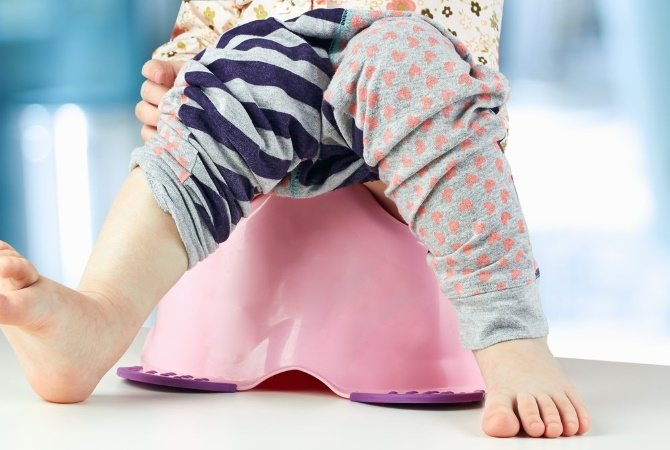
It is much worse if white diarrhea is caused by intoxication (a condition equivalent to poisoning, which develops under the influence of various poisons and toxins that enter the body from the external environment) or any serious diseases.
Bile duct diseases
Biliary dyskinesia in a child is a failure of the process of bile formation and bile secretion. Stagnation of bile is formed, which leads to poor functioning of the gastrointestinal tract, the motor activity of the gallbladder and biliary tract is disrupted without their organic changes.
Blockage of the bile ducts is often accompanied by loose stools and white feces. The normal color of feces is ensured by the presence of bile acid impurities in them. When this substance is not released into the duodenum in the required volume, the color of the stool gradually changes and becomes lighter, even white.
With biliary dyskinesia, the absorption of nutrients, especially fats, deteriorates. After all, in order for fats to be better digested, they must be broken down into smaller “droplets”, and this function is performed by bile. Biliary dyskinesia is usually accompanied by reactive pancreatitis - an inflammatory process in the pancreas.
Cholangitis is an inflammation of the bile ducts that occurs against the background of obstruction of the biliary tract or bacterial infection of the bile itself. It can also cause white diarrhea in a child.
Cholecystocholangitis in children is usually of an infectious nature: bacterial, viral, fungal. May be of toxic origin. The connection of this inflammation of the biliary tract with appendicitis, scarlet fever, dysentery, sepsis, sore throat, chronic tonsillitis, sinusitis, dental caries, infectious hepatitis (Botkin), helminthiasis, tuberculosis intoxication has been proven.
Cholecystocholangitis in children occurs more often as a primary chronic disease. It requires long-term treatment with mandatory medical examination of patients for 3-4 years.
Taking medications
The intestinal microflora is disrupted for various reasons. Most often, dysbiosis develops after prolonged use of antibiotics; in rare cases, this causes white diarrhea.
Drugs that interfere with liver function can cause white diarrhea in a child:
- Tetracycline;
- Aspirin;
- Ibuprofen;
- Paracetamol;
- Methotrexate.
Diarrhea after antibiotics in a child is caused by the same circumstance - the death of beneficial microflora. Antibacterial drugs in many cases become indispensable in the treatment of diseases of the upper respiratory tract, but at the same time they can affect both pathogenic microorganisms and beneficial ones with equal force.
Microflora disturbance
Modern pediatricians believe that dysbiosis is not a disease, but a condition of the mucous membranes in which the balance of the microflora is disturbed. Dysbacteriosis in children under one year of age is a very common phenomenon. The work of the gastrointestinal tract of a newborn is still just getting better, and there may not be enough beneficial bacteria for stable intestinal function.
If a child has taken antibiotics, the natural microflora of his intestines is disrupted, because antibiotics kill any bacteria, without distinguishing whether they are pathogenic or beneficial. It can also be caused by poor diet, stress and other factors. Symptoms in a child, including white diarrhea, with dysbacteriosis appear quite clearly and cause discomfort, especially for infants.
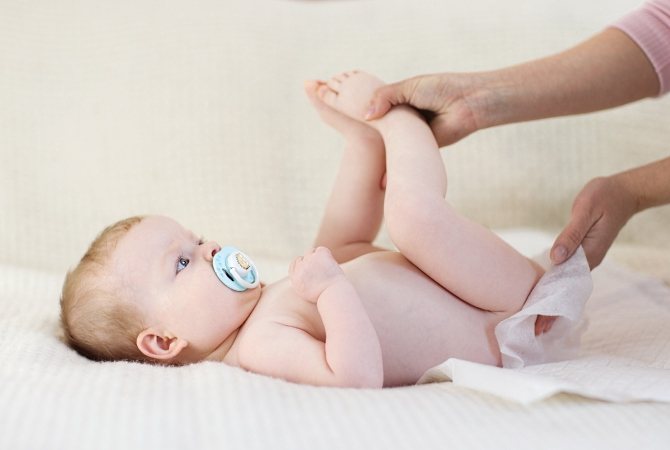
Colitis
This disease is inflammatory and is characterized by dystrophic changes in the large intestine. Among its symptoms are periodic abdominal pain, bloating, diarrhea or frequent urge to defecate, chills, dehydration, and blood clots in the stool.
Treatment of colitis can be surgical and therapeutic. Surgery is indicated if other measures have failed and the child continues to suffer from pain and diarrhea. In addition, surgery is prescribed if a diagnosis of ischemic colitis, Crohn's disease or nonspecific colitis is made.
Colitis in children often occurs due to dietary errors, poisoning and lack of sufficient fluids drunk during the day. It must be remembered that the disease is quite simple to prevent; you just need to monitor what the child eats and drinks.
Helminthiasis
Worm infestations are one of the most common diseases in childhood. Parents often underestimate their danger, but helminths in children provoke not only an insufficient supply of nutrients to the body, but also cause allergic reactions, chronic intoxication, reduce immunity and contribute to the development of diseases of the gastrointestinal tract. Childhood is a period when stable immunity has not yet been formed, which significantly increases the likelihood of infection with parasites. And the methods of infection by worms depend on the characteristics of their development cycle.
The first signs, as a rule, are detected 2-4 weeks after the eggs enter the body. They vary depending on the number of parasites, the state of the child’s immunity, and the type of helminths.
In most cases, helminthiases in childhood are diagnosed through annual preventive stool examinations for worm eggs. In case of negative stool tests, a repeat test is recommended after 2-3 weeks.
Rotavirus infection
It is characterized by symptoms similar to respiratory diseases - runny nose, headache, cough and sore throat. Fever and intoxication are also possible.
Typically, this infection causes a change in the color of the child's stool - it becomes white-yellow or whitish. The child loses his appetite, becomes sleepy and capricious. To quickly relieve all symptoms, you should seek medical help.
Hepatitis
Hepatitis in newborns and children in the first months of life refers to inflammatory processes in the liver caused by various infectious agents.
There may be no symptoms of hepatitis, but if parents notice dark urine in their child, they should be wary, because this is a sure sign of the disease. A child's stool with hepatitis is not just white, but has a grayish tint.
An accurate diagnosis can be established only after examination and laboratory tests. The disease discovered in a child can be cured - it is possible to completely restore all lost liver functions if adequate therapy is selected.
Dehydration
Dehydration, which often occurs in children due to acute respiratory viral infections and intestinal infections, is a dangerous condition that can threaten the health and even the life of the child. Dehydration is a sudden loss of fluid in the body or insufficient intake.
The main cause of rapid dehydration is vomiting and diarrhea, which usually accompany intestinal infections, rotavirus, and exacerbation of gastrointestinal diseases. In children, dehydration occurs quickly - the younger the child, the faster a life-threatening condition can occur.
Dehydration is dangerous for the entire body as a whole and for each organ separately. When fluid is lost, the functioning of the main systems - the kidneys, brain and heart - is disrupted, which can lead to convulsions, heart rhythm disturbances, loss of consciousness and other life-threatening consequences. Therefore, if a child has white diarrhea, it is worth considering whether he is getting enough fluids.
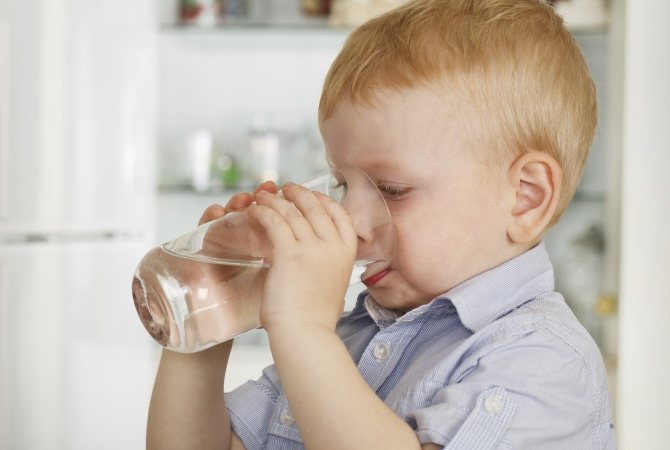
Rotavirus infection
In children under 2 years of age, bright yellow diarrhea can actually develop due to rotavirus infection. The most common symptoms are:
- temperature rise to 39 degrees;
- presence of cough, runny nose or sore throat;
- general malaise;
- signs of dehydration.
At the same time, deterioration in well-being develops at lightning speed and progresses in an acute form. The color of stool usually changes gradually. That is, at first its color is normal, later it becomes light yellow, and some time later it becomes almost transparent. The stool may also be accompanied by whitish or yellow foam.
How to treat a child for rotavirus infection? The usual diet correction will not be enough here. Consultation with a pediatrician is mandatory. He, as a rule, prescribes taking saline solutions (for example, Regidron), vitamins (in the form of drops) and rinsing the nasopharynx with a non-concentrated solution of sea salt (depending on the location of the inflammation).
Vomiting with yellow diarrhea
Particular attention should be paid to vomiting with diarrhea. Nausea is a very serious symptom that indicates an intestinal infection, especially if it is accompanied by a fever. Also, if the intestinal mucosa is irritated, diarrhea may be accompanied by bloody discharge and a rash in the anus.
Also, diarrhea with vomiting has a very large effect on dehydration. In this case, you need to pay attention to the following symptoms:
- Dry mouth;
- Reducing the child's weight;
- Infrequent urination of dark yellow color;
- Weakness, drowsiness;
- Loss of appetite and constant feeling of thirst.
If all of the above is present, you must immediately consult a doctor and, if necessary, undergo treatment in a day hospital.
Yellow diarrhea when introducing complementary foods
As a rule, there should be no diarrhea when introducing complementary foods if you follow the diet correctly. The feces themselves become more dense. Diarrhea in this case is a sign of excessive stress on the gastrointestinal tract or immunity to certain foods. The stool has a color from pale green to light yellow. The first option indicates an increase in the concentration of histamines, the second indicates indigestion in the stomach. Children react acutely to this, so diarrhea can be accompanied by nausea and bouts of vomiting.
What to do in such cases? Temporarily stop complementary feeding and return to breastfeeding or artificial milk formula. If your stool does not return to normal during the day, you should contact your pediatrician. Until this moment, the baby can only be given breast milk and dill water.
In summary, yellow diarrhea is not always a sign of a serious illness in a child. Before the age of 1 year, bowel movements are normal. Older - may indicate an infectious disease, allergies, or indigestion of certain foods. The main thing is that this is not accompanied by excessive vomiting, increased body temperature, or the appearance of foam in the stool.
Causes of water diarrhea in a child
The most common causes of water diarrhea in a child include the following factors:
- Intestinal infections. In this case, in addition to watery diarrhea, the child also experiences vomiting, fever, abdominal pain, nausea and other symptoms. In case of intestinal infections, you should seek medical help, as they can cause rapid dehydration, which is dangerous to the health and even life of the child. The baby must be given small amounts of water frequently so as not to provoke repeated vomiting. As a drink, it is better to use special preparations sold in pharmacies, or a self-prepared saline solution.
- Dysbacteriosis. It consists in changing the normal microflora. In this case, the stool may acquire a greenish color, a specific sour odor and a foamy consistency. With dysbacteriosis, diarrhea is often replaced by constipation. The disease is treated under the supervision of a doctor. It can develop after treatment with antibiotics. To prevent dysbiosis after such therapy, it is worth taking a course of drugs with lacto and bifidobacteria.
- Overeating and poor diet. Water diarrhea in a child can occur when overeating or consuming certain foods. Sweets, berries, fruits and raw vegetables especially often cause diarrhea.
- Colds. With acute respiratory diseases, in addition to their typical symptoms, the child often develops diarrhea. In such cases, treatment of diarrhea comes down to preventing dehydration and choosing a diet that excludes heavy foods. The main attention should be paid to the underlying disease and its treatment.
- Intolerance to certain foods. More often, this type of diarrhea is observed when introducing complementary foods to small children or consuming a product that is new to the child. Watery diarrhea can be caused by grains, honey, cow's milk, certain fruits and vegetables, and juices and purees made from them.
- Stressful situations such as neurosis, strong anxiety, fear, etc. Such diarrhea is not dangerous. To get rid of it, you need to find the cause of the child’s worries and calm him down.
